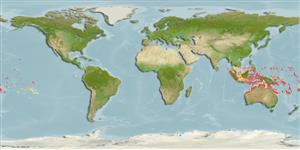Common names from other countries
>
Gobiiformes (Gobies) >
Gobiidae (Gobies) > Gobiinae
Etymology: Eviota: No etymology given, suggested by Christopher Scharpt: from Latin 'eu' for 'true' and 'iota' for anything very small, in combination 'truly very small' referring to it as being the smallest vertebrate at the time it has benn described by Jenkins (thus, making the suggestion by Scharpt plausible..
More on authors: Jordan & Seale.
Environment: milieu / climate zone / depth range / distribution range
экология
морской ассоциированный с рифами; пределы глубины 1 - 30 m (Ref. 86942). Tropical; 10°N - 23°S
Western Pacific: Vietnam, Indonesia (Moluccas), east and northward to Japan (Ryukyu Islands); east through Micronesia (Palau, Guam, Federated States of Micronesia [Yap], Kiribati [Gilbert Islands]); including New Caledonia, Samoa, and French Polynesia; south through Melanesia to Australia (Great Barrier Reef).
Size / Вес / Возраст
Maturity: Lm ? range ? - ? cm
Max length : 3.0 cm SL самец/пол неопределен; (Ref. 48637)
Краткое описание
определительные ключи | морфология | морфометрия
колючие лучи спинного плавника (общее число) : 7; членистые (мягкие) лучи спинного плавника (общее число) : 8 - 9; колючие лучи анального плавника: 1; членистые (мягкие) лучи анального плавника: 6 - 7. This species is distinguished by the following characters: cephalic sensory-canal pore system lacks the IT pore (pattern 2); unbranched pectoral-fin rays; dorsal/anal-fin formula is 8/7; fifth pelvic-fin ray 40% of fourth ray; abdomen without the black peritoneum clearly visible externally; upper portion of pectoral-fin base with a dark spot when dead, and which is lacking or less visible in life; when alive. there is a distinctive red line running from the tip of the lower jaw back under the eye across the cheek (Ref. 107299).
Inhabits rubble of lagoon reefs (Ref. 37816). Also occurs in various reef habitats to about 15 meters depth (Ref. 48637). Occurs in small groups (Ref 90102).
Life cycle and mating behavior
Maturities | размножение | Spawnings | Egg(s) | Fecundities | личинки
Myers, R.F., 1991. Micronesian reef fishes. Second Ed. Coral Graphics, Barrigada, Guam. 298 p. (Ref. 1602)
Статус Красного Списка МСОП (Ref. 130435)
CITES (Ref. 128078)
Not Evaluated
Угроза для людей
Harmless
Использование человеком
дополнительная информация
инструменты
Специальные отчеты
Скачать в формате XML
ресурсы в Интернет
Estimates based on models
Phylogenetic diversity index (Ref.
82804): PD
50 = 0.5000 [Uniqueness, from 0.5 = low to 2.0 = high].
Bayesian length-weight: a=0.00708 (0.00333 - 0.01504), b=3.09 (2.92 - 3.26), in cm Total Length, based on LWR estimates for this (Sub)family-body shape (Ref.
93245).
Trophic level (Ref.
69278): 3.1 ±0.3 se; based on size and trophs of closest relatives
устойчивость к внешним воздействиям (Ref.
120179): высокий, минимальное время удвоения популяции до 15 месяцев (Preliminary K or Fecundity.).
Fishing Vulnerability (Ref.
59153): Low vulnerability (10 of 100).
